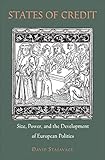States of credit : size, power, and the development of European polities / David Stasavage.
Material type: TextSeries: Princeton economic history of the Western worldPublication details: Princeton, N.J. : Princeton University Press, c2011Description: viii, 192 p. : ill. ; 24 cmISBN: 9780691140575 (hardcover : alk. paper); 069114057X (hardcover : alk. paper)Subject(s): Debts, Public -- Europe -- History | Credit -- Europe -- History | Europe -- Politics and government | Europe -- History | Middle AgesDDC classification: 336.3/4094 LOC classification: HJ8615 | .S857 2011
TextSeries: Princeton economic history of the Western worldPublication details: Princeton, N.J. : Princeton University Press, c2011Description: viii, 192 p. : ill. ; 24 cmISBN: 9780691140575 (hardcover : alk. paper); 069114057X (hardcover : alk. paper)Subject(s): Debts, Public -- Europe -- History | Credit -- Europe -- History | Europe -- Politics and government | Europe -- History | Middle AgesDDC classification: 336.3/4094 LOC classification: HJ8615 | .S857 2011| Item type | Current library | Collection | Call number | Copy number | Status | Date due | Barcode |
|---|---|---|---|---|---|---|---|
 Book
Book
|
University of Macedonia Library Βιβλιοστάσιο Α (Stack Room A) | Main Collection | HJ8615.S857 2011 (Browse shelf (Opens below)) | 1 | Available | 0013138469 |
Includes bibliographical references (p. [167]-186) and index.
Introduction -- The evolution and importance of public credit -- Representative assemblies in Europe, 1250-1750 -- Representation and credit in a broad sample of states -- Origins of city-states -- Three city-state experiences -- Three territorial state experiences -- Implications for state formation and development.
States of Credit provides the first comprehensive look at the joint development of representative assemblies and public borrowing in Europe during the medieval and early modern eras. In this pioneering book, David Stasavage argues that unique advances in political representation allowed certain European states to gain early and advantageous access to credit, but the emergence of an active form of political representation itself depended on two underlying factors: compact geography and a strong mercantile presence. Stasavage shows that active representative assemblies were more likely to be sustained in geographically small polities. These assemblies, dominated by mercantile groups that lent to governments, were in turn more likely to preserve access to credit. Given these conditions, smaller European city-states, such as Genoa and Cologne, had an advantage over larger territorial states, including France and Castile, because mercantile elites structured political institutions in order to effectively monitor public credit. While creditor oversight of public funds became an asset for city-states in need of finance, Stasavage suggests that the long-run implications were more ambiguous. City-states with the best access to credit often had the most closed and oligarchic systems of representation, hindering their ability to accept new economic innovations. This eventually transformed certain city-states from economic dynamos into rentier republics. Exploring the links between representation and debt in medieval and early modern Europe, States of Credit contributes to broad debates about state formation and Europe's economic rise.





There are no comments on this title.